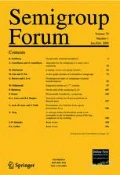Abstract
We obtain sharp quantitative bounds which describe how an eigenspace of the Dirichlet Laplacian defined on a smooth domain changes when the smooth domain is replaced by a slightly smaller domain.
Similar content being viewed by others
References
Alvarado, R., Brigham, D., Maz’ya, V., Mitrea, M., Ziade, E.: On the regularity of domains satisfying a uniform hour-glass condition and a sharp version of the Hopf-Oleinik boundary point principle. J. Math. Sci. 176, 281–360 (2011)
Burenkov, V.I., Feleqi, E.: Spectral stability estimates for the eigenfunctions of second order elliptic operators. Math. Nachr. 285, 1357–1369 (2012)
Burenkov, V.I., Lamberti, P.D., Lanza de Cristoforis, M.: Spectral stability of nonnegative self-adjoint operators. J. Math. Sci. 149, 1417–1452 (2008)
Davies, E.B.: Pointwise bounds on the space and time derivatives of heat kernels. J. Oper. Theory 21, 367–378 (1989)
Davies, E.B.: Heat Kernels and Spectral Theory. Cambridge University Press, Cambridge (1989)
Davies, E.B., Pang, M.M.H.: The eigenvalue gap for second order elliptic operators with Dirichlet boundary conditions. J. Differ. Equa. 88, 46–70 (1990)
Davies, E.B., Simon, B.: Ultracontractivity and the heat kernel for Schrodinger operators and Dirichlet Laplacians. J. Funct. Anal. 59, 335–395 (1984)
Pang, M.M.H.: Approximation of ground state eigenvalues and eigenfunctions of Dirichlet Laplacians. Bull. Lond. Math. Soc. 29, 720–730 (1997)
Pang, M.M.H.: Stability and approximations of eigenvalues and eigenfunctions for the Neumann Laplacian, Part 2. J. Math. Anal. Appl. 345, 485–499 (2008)
Pang, M.M.H.: Stability and approximations of eigenvalues and eigenfunctions for the Neumann Laplacian, Part 3. Electron. J. Diff. Equa. 100, 1–54 (2011)
Pang, M.M.H.: On an upper heat kernel bound for second order elliptic operators on bounded regions in \(\mathbb{R}^N\). Oper. Matrices (2014, accepted)
Author information
Authors and Affiliations
Corresponding author
Additional information
Communicated by Jerome A. Goldstein.
Appendix
Appendix
In [11], \(H \geqslant 0\) is a second order uniformly elliptic operator in divergence form defined on a domain \(\Omega \subseteq \mathbb {R}^N, N \geqslant 3,\) with Dirichlet boundary conditions. Let \(E_1 > 0\) be the ground state eigenvalue of \(H\), \(\phi _1 > 0\) be the ground state eigenfunction of \(H\), normalized so that \(\left\| \phi _1\right\| _{L^2(\Omega )} = 1\), and let \(K(t, x, y)\) be the heat kernel of \(e^{-Ht}\). It is assumed in [11] that (i) there exist \(0 < \lambda \leqslant \Lambda < \infty \) such that
where \(-\Delta _{\Omega } \geqslant 0\) denotes the Dirichlet Laplacian defined on \(\Omega \), that (ii) there exists \(c_1 = c_1(\Omega ) \geqslant 1\) such that \(\Omega \) satisfies a strong Hardy’s inequality of the form
and that (iii) there exist \(a \geqslant 1\) and \(b > 0\) such that \(\phi _1\) satisfies an inequality of the form
Then [11, Theorem 16] asserts that there exists \(c_{2}=c_{2}(\Omega ) \geqslant 1\) such that if we put
then we have
for all \(t>0\) and all \(x,y\in \Omega .\)
In the main body of this paper if \(\Omega \) is a bounded \(C^{1,1}\) domain in \(\mathbb {R}^N\), \(N \geqslant 3\), and \(H=-\Delta _{\Omega },\) then it is well known that the assumptions in [11] are satisfied and we can put \(\lambda =\Lambda =a=1\) in (145). Noting in this case that \(b\) and \(E_1 = \mu _1[\Omega ]\) both depend only on \(\Omega \), we get the upper heat kernel bound, in the notations of the main body of this paper,
for some \(c(\Omega )\geqslant 1\). Clearly (146) implies that for all \(0 < \delta < 1\) we have
for some \(c(\Omega , \delta ) \geqslant 1\). If we fix \(\delta = 1/3\), then we get the bound (2) in this paper.
Suppose next that \(\Omega \) is a \(C^{1, 1}\) bounded domain in \(\mathbb {R}^2\), then, as mentioned in [6], we consider \(\Omega \times \Omega \subseteq \mathbb {R}^4\). Recall that a domain \(D \subseteq \mathbb {R}^N\), \(N \geqslant 2,\) is said to satisfy a uniform external ball condition with parameters \(\alpha > 0\) and \(\beta > 0\) if for any \(y \in \partial \Omega \) and \( 0 < s < \beta \) there exists a ball \(B_{p, r} \) with center \(p\) satisfying \(\left| p - y\right| \leqslant s\), and radius \(r\) satisfying \(r \geqslant 2\alpha s\), which does not meet \(D\). This condition holds if \(\partial D\) satisfies a uniform Lipschitz condition. It is easy to check that if \(D \subseteq \mathbb {R}^N, N \geqslant 2,\) satisfies a uniform exterior ball condition with parameters \(\alpha \) and \(\beta \), then \(D \times D \subseteq \mathbb {R}^{2N}\) satisfies a uniform exterior ball condition with parameter \(\alpha /\sqrt{2}\) and \(\beta \). By [5, Theorem 1.5.5.], a domain \(D\subseteq \mathbb {R}^N, N \geqslant 2,\) that satisfies a uniform external ball condition and has finite inradius, i.e.,
automatically satisfies a strong Hardy’s inequality. Applying these to \(\Omega \) we see that \(\Omega \times \Omega \subseteq \mathbb {R}^4\) satisfies a strong Hardy’s inequality. Moreover, since
we have, by (1),
for some \(c_1=c_1(\Omega ) \geqslant 1.\) So \(-\Delta _{\Omega \times \Omega }\) satisfies all the assumptions in [11] and we can apply the bound (145) to it with \(\lambda = \Lambda = 1, a=2\), \(b=b(\Omega ) = c_1(\Omega )^{-2}\) and \(E_1 = E_1(\Omega ) = 2\mu _1[\Omega ] .\) So we get
for some \(c(\Omega ) \geqslant 1\). Since for all \(x_1, x_2, y_1, y_2 \in \Omega \) we have
(148) implies that (146), and hence (147), hold also if \(N = 2\). Hence (2) holds also if \(\Omega \subseteq \mathbb {R}^2\).
Rights and permissions
About this article
Cite this article
Pang, M.M.H. Sharp bounds for domain perturbations of Dirichlet Laplacians defined on smooth domains. Semigroup Forum 90, 1–52 (2015). https://doi.org/10.1007/s00233-014-9665-1
Received:
Accepted:
Published:
Issue Date:
DOI: https://doi.org/10.1007/s00233-014-9665-1



